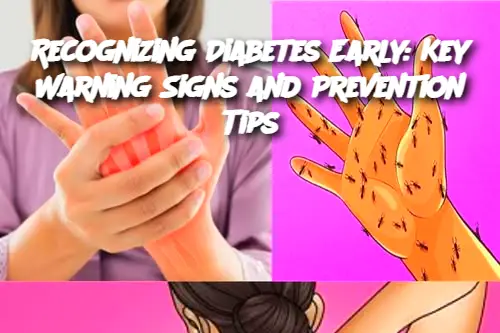ADVERTISEMENT
Introduction: Diabetes is a chronic condition that affects millions of people worldwide. While it is manageable, early detection is crucial for better outcomes and to prevent complications. Unfortunately, many individuals with diabetes may not notice symptoms in the early stages, which is why it’s important to know the warning signs. Recognizing these signs early can make a significant difference in managing the condition. This article provides an overview of the seven key warning signs of diabetes and practical advice on how to spot the disease early.
How to Spot Diabetes Early: 7 Warning Signs You Shouldn’t Ignore
Excessive Thirst (Polydipsia) If you find yourself feeling incredibly thirsty all the time, despite drinking more fluids than usual, it might be a sign of diabetes. This occurs because the body is trying to flush excess sugar from the bloodstream through urine, causing dehydration.
Frequent Urination (Polyuria) High blood sugar levels can cause the kidneys to work overtime to remove sugar from the blood. This leads to an increased need to urinate, particularly during the night. If you notice more frequent bathroom trips, it’s time to consult a healthcare provider.
Unexplained Weight Loss Weight loss that happens suddenly, without a change in diet or exercise routine, could indicate that your body is not absorbing glucose properly. As a result, your body may start breaking down muscle and fat for energy, leading to unexplained weight loss.
Fatigue People with diabetes often feel tired and weak. This is because the body isn’t able to use glucose effectively for energy, leaving you feeling drained. Fatigue can be a red flag, especially when it occurs alongside other symptoms.
Blurred Vision High blood sugar levels can cause the lenses of the eyes to swell, leading to blurry vision. If your vision changes suddenly or you notice difficulty focusing, it might be a sign that your blood sugar is elevated.
Slow Healing of Cuts and Wounds Diabetes affects the body’s ability to heal wounds quickly. If you notice that cuts, bruises, or infections take longer than usual to heal, it could be due to high blood sugar levels impairing your immune system and circulation.
Numbness or Tingling in Hands or Feet High blood sugar can lead to nerve damage, a condition known as diabetic neuropathy. This often results in a tingling, burning, or numb sensation in the hands or feet. If you experience any of these sensations, it’s important to seek medical advice.
Ingredients: To understand diabetes prevention and management, maintaining a balanced diet is key. The following ingredients should be prioritized for better overall health and diabetes management:
Whole grains (brown rice, quinoa, oats)
Lean proteins (chicken, turkey, legumes)
Healthy fats (avocados, nuts, seeds)
Low-glycemic fruits and vegetables (leafy greens, berries, carrots)
High-fiber foods (lentils, beans, chia seeds)
Preparation: For people at risk of diabetes, lifestyle changes play a significant role in prevention. Regular exercise, a balanced diet, stress management, and routine check-ups can all contribute to healthier blood sugar levels. It's important to start early and maintain consistency to reduce the chances of developing the condition.
Presentation and Storage Tips: For individuals already diagnosed with diabetes, meal planning and food presentation can help ensure better control over blood sugar. Store healthy snacks and meals in portion-controlled containers and consider meal prepping for the week. This reduces the temptation to indulge in sugary or processed foods and helps maintain consistent eating habits.
Variants:
ADVERTISEMENT
